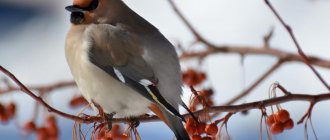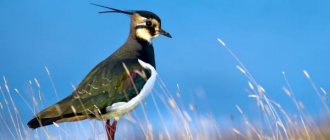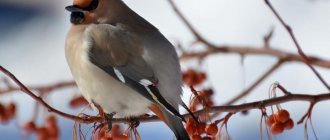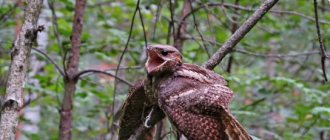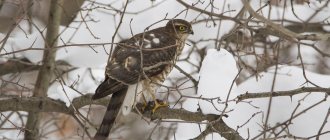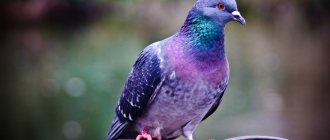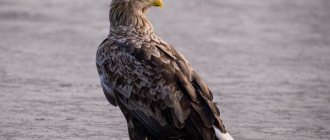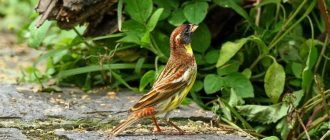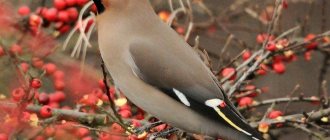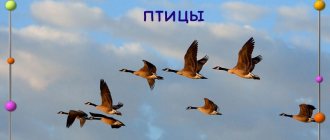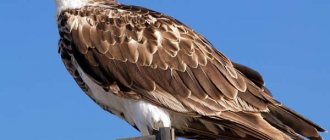What birds with a crest are found in Russia.
The territory of our country is a habitat for many species of birds. The permanent habitats of birds in Russia are extensive and are located in several dozen climatic zones. Birds that live in vast areas are distinguished by their unusual appearance. The lifestyle of various families of birds is also of interest. Birds with an original decoration on their heads in the form of a crest are of considerable interest to those who are not indifferent to the animal and plant world.
Winter bird with a crest on its head - waxwing: description, photo
- The waxwing is a spectacular crested winter bird. Does not differ in large sizes. The body length reaches 15-18 cm. The maximum weight of this bird is 70 grams.
- The brownish-gray color of the plumage and red spots make the birds stand out against the background of their more modestly colored relatives. The waxwing has black plumage on its wings, tail, head and throat. White and yellow stripes are clearly visible on a black background.
Where do they live?
You can meet the waxwing in the warm season in Siberia, in the northern regions (taiga, forest-tundra). The oncoming cold forces these birds to migrate to more southern regions, so in winter residents of cities and towns in the Moscow region, Crimea, the Caucasus, and Central Asia can observe the waxwing.
You can meet the waxwing in the warm season in Siberia, in the northern regions (taiga, forest-tundra).
What do they eat?
- The waxwing's diet in summer consists mainly of insects. However, birds supplement it with cone seeds and birch buds.
- In winter, the waxwing, like many other bird species, is forced to change its diet: at this time, the fruits of rowan, hawthorn, and rose hips become food for the bird. Birds usually swallow them whole, and the fruits do not always have time to be digested in the stomach.
What does waxwing eat?
Are drunken waxwings a fiction?
- The waxwing can become intoxicated after eating fermented fruits. This also happens in the spring, when birds begin to feed on tree sap (maple, etc.).
- After such “feeding” the birds may behave inappropriately. They can be aggressive towards relatives and animals, which leads to injury and even death.
Can waxwings be drunk
? How are chicks hatched?
- Pieces of moss, lichens, dry twigs of grass - all this becomes building material when constructing a nest. Waxwings use feathers and down as bedding. Having found a mate, the gentleman treats the female to berries.
- A waxwing clutch usually contains 3-7 eggs. The color of the eggs may be gray or purple. There are specks on the shell. On the 14th day of incubation, chicks appear in the nest, which will become independent and capable of short flights after two weeks.
- Young waxwings join flocks of birds. The number of individuals in such flocks is 5 or 30 birds.
Waxwing nutrition
In their homeland, waxwings feed on berries, small fruits, buds, young shoots and insects. Birds have become adept at grabbing mosquitoes, dragonflies, butterflies and midges on the fly and finding larvae. In autumn, waxwings have to fly away from these places not so much from the cold as from hunger. They are driven by the need to find places where there is a lot of food. Waxwings usually become "vegetarians" during their travels. If there are a lot of berries, then the birds stop for a while and eat their fill. They like the berries of rowan, juniper, viburnum, rose hips, barberry and other trees and shrubs.
Waxwings have an excellent appetite. Voracious waxwings eat a lot and quickly. They swallow the berries whole. In such quantities that their stomachs do not have time to digest food. It's funny, but you can tell about the arrival of these birds by their droppings. Orange-red spots of half-digested berries with remnants of peel and seeds stain steps, blind areas and areas in front of houses. Seeds “from waxwings” germinate in the most random places. These birds sometimes visit feeders and willingly peck seeds and dried berries.
After several weeks of gluttony, the flocks fly away, wandering from one place to another. The flight distance depends on the amount of food in new places. At the end of winter - at the beginning of spring, waxwings reappear in the Moscow region, feeding on the remaining berries and swollen buds of aspens and poplars.
Waxwings on wires
A bird with a crest on its head, hoopoe: description, photo
The hoopoe is also a species of bird with a beautiful crest. The size of this bird is almost the same as waxwings. The long curved beak of the hoopoe reaches 4-6 cm in length.
What does it look like?
- Nature has given the hoopoe a bright color: the bird has a reddish back, black wings and tail decorated with white stripes. But the main decoration of the bird is the crest.
- It is painted red. There is a black border on the crest. When the bird is calm, the crest is folded. In other cases, it proudly rises above the bird's head.
A bird with a crest on its head, hoopoe: description
Where does it live?
- The habitat of the hoopoe is Siberia, Transbaikalia, and the Far East. Birds settle on open plains or in forest-steppe. The bird runs quickly on the ground.
- When the hoopoe is in danger, it presses itself to the surface of the earth. At the same time, the bird’s wings are spread, and the hoopoe’s beak is raised threateningly upward.
Where does the hoopoe live
? What does it eat?
- The hoopoe's diet includes insects. The bird can even eat small reptiles (young lizards, snakes).
How are chicks hatched?
- Dense thickets become a place where birds nest. The droppings left on nesting sites have such an unpleasant odor that they themselves become protection against enemies.
- The female usually hatches 3-8 eggs, from which chicks hatch after 2 weeks. The chicks that fly out of the nest remain under the care of their parents for a long time.
How a hoopoe hatches its chicks
Nicobar (Maned) Pigeon
Among the pigeons there are stunning specimens. The Nicobar maned pigeon was found on the islands of the Bay of Bengal. This species is considered the most luxurious among its relatives. Long, thin green-blue feathers that shimmer in the sun adorn the bird’s chest. They give the pigeon a unique look. But only males have such beauty.
Female maned doves are small and inconspicuous. Yes, they have no need for beauty. Their task is to incubate the chicks. And this activity in the wild is dangerous. The mother pigeon must be invisible to numerous enemies.
A bird with a crest on its head, a lark: description, photo
The lark is a small bird. Her body length is 19 cm, and she weighs only 45 g.
What does it look like?
- The grayish-brown color of the bird plays a protective role: in times of danger, the lark presses to the ground and becomes invisible.
- The crested lark has a small crest on its head. There are dark spots on the back of the lark, and black and white spots in the area of the crop and chest.
Bird with a crest on its head, lark
Where does it live?
- The bird prefers open spaces, abundantly overgrown with short grass.
- They settle in the steppe, in sand pits, on roadsides, and railway embankments. With the onset of cold weather, birds are forced to migrate to more southern areas.
What does it eat?
- Since the crested lark is a terrestrial bird, it finds food on the surface of the earth without flying.
- The lark's diet includes beetles, grasshoppers, caterpillars, spiders, and large earthworms. The lark also feeds on plant seeds. In winter, grass seeds become the main food for larks.
What does the crested lark eat
? How are the chicks hatched?
- A crested lark's clutch usually contains 3-5 eggs. The shell is off-white or yellowish. Chicks appear 12-14 days after the start of brooding.
- Parents feed their offspring for 9-10 days.
How a lark hatches chicks
crowned pigeon
It's hard to take your eyes off this dove. The hefty bird can weigh up to 3.5 kg! This is not only a giant among pigeons, but also a stunning beauty. Crowned pigeons live in Indonesia and New Guinea.
Its plumage has a beautiful ultramarine or blue-gray color. The small head is crowned with a lace crown of feathers that look like thin blades of grass. Both sexes have such a crown. They fluff it up during wedding dances.
Bird with a crest on its head lapwing: description, photo
Another notable representative of the crested birds is the lapwing. The bird has bright plumage, and it differs from its relatives in its larger size (28-30 cm - body length). The lapwing weighs 130 - 330 grams.
What does it look like?
- The bird's body is covered with black and white plumage.
- The surface of the wings has a purple tint, on which greenish-blue and yellow shades can be distinguished. The bird's crest is made of long feathers.
Lapwing - a bird with a crest on its head
Where does it live?
- Lapwing settles in open areas, abundantly covered with vegetation, often choosing wetlands, corn or potato fields, and wet meadows.
What does it eat?
- Insects and invertebrate animals serve as food for lapwings in the warm season.
Where does the lapwing live?
Lapwing in flight
How does it hatch chicks?
- A formed pair of birds builds a nest directly on the ground, choosing depressions for this. The bottom of the lapwing's nest is lined with dry twigs and grass.
- There are usually no more than 4 eggs in a clutch. Parents take turns incubating their future offspring for 28 days. Birds may die during harvesting because birds nest in the planted field.
Gray crowned crane
This large, beautiful bird is the national symbol of Uganda. She has chosen the swamps and water meadows of the southeastern regions of the African continent. The neck and body of the crane are covered with light gray feathers, the wings are dark gray with beige areas, and the luxurious thick tail is dark brown. The bird's head is covered with a black cap, which is crowned with a golden crown of the finest fluffy feathers.
9
A bird with a crest on its head, a jay: description, photo
Jay is also a crested bird that stays for the winter in Russia. The body length of this bird reaches 15 cm. The weight of an adult is only 200-250 g. The bird has reddish-brown plumage. In the shoulder area the plumage is bright blue, “crossed out” with black stripes. The jay has a long, black tail, and a white rump.
Bird with a crest on its head jay
Nature has endowed the jay with the ability to move around a tree. The bird performs these actions thanks to its long and flexible fingers, on which sharp curved claws grow.
What does it eat?
- The basis of the jay's diet is insects, even large beetles. The bird copes with their dense shell using its curved beak.
- The jay will not refuse small rodents, lizards, and frogs. In winter, acorns and berries serve as food for birds.
Where does the jay live
? How does it hatch its chicks?
- For nesting, jays choose deciduous forests and areas with bushes. They nest in old hollows or find secluded places in the crown of trees.
- There are usually 5-10 eggs in a clutch. The shell has a greenish, light yellow color.
Guinean Turaco
This small bird has exceptionally beautiful green plumage on the upper body. Towards the tail the green color darkens and turns into dark purple. Turaco lives in the equatorial thickets and green savannas of Africa.
The most spectacular feature of the bird is its bright triangular crest of delicate, thin, bright green feathers. The red beak and eyes, outlined in bright red, give the appearance of bright berries against the foliage. This camouflage helps her to be invisible among the greenery of the forest.
8
Bird with a tuft on its head, woodpecker: description, photo
Another striking representative of birds with a crest-shaped decoration on their head is the woodpecker. The size of the bird is from 7 cm to 27 cm, and its weight is from 60 to 600 g.
What does it look like?
The bird has a large, strong skull, adapted for hollowing out insects and their larvae from diseased and old trees. The tail is wedge-shaped. This helps the bird to lean on the trunk while foraging. The bird's plumage is black with white stripes and spots. The undertail is red.
What does a woodpecker eat?
Where does he live?
The woodpecker often settles in the forest zone. But it is able to adapt to existence in any biotype. You can meet this bird both in the taiga and in the city park.
golden woodpecker
What do they eat?
The woodpecker's diet includes insects, acorns, nuts, and coniferous seeds.
How are chicks hatched?
The chicks are hatched in tree hollows hollowed out by the male. There are from 4 to 8 white eggs in the clutch. The offspring appear 12-13 days after the start of incubation.
How woodpeckers hatch chicks
Golden pheasant
The homeland of this stunning bird is China. The bright red plumage and long golden-brown tail make this bird extremely beautiful. But that is not all. The arrogant head of the golden pheasant is especially beautiful. She is decorated with a magnificent crest of thin bright yellow feathers, which combine effectively with the striped orange and black frill on the neck.
6
Bird with a crest on its head, bunting-remez: description, photo
- Let's look at another representative of crested birds. This is a remez bunting, which in appearance resembles a sparrow. The size of the bird is 15 cm, and its weight is only 16-20 g.
- The bird is reddish-brown. There are white and red stripes on the body. The crest of this bird is small, but in males it is larger than in females. Thanks to its short, strong beak, the bird is able to easily clean grains.
- The oatmeal does not immediately feed the chicks dry food. Before feeding, she holds the food in her beak for some time, soaking it.
Where does he live?
- Bunting loves the open spaces of the north of the country, mainly in the steppe regions (Siberia, Far East).
- In summer it settles in swamps where shrubs grow, and also chooses swampy river valleys.
- With the onset of cold weather, birds are forced to fly to a warmer climate zone. These are areas of East Asia.
Bird with a crest: bunting
What does it eat?
- The main food of oatmeal is insects. The bird eats grain crops and berries.
How does it hatch chicks?
The bunting hides its nest well from uninvited guests on the ground, in a hole. Sometimes a bunting's nest can be seen on a bush. It looks like a bowl, which birds “construct” from the stems and leaves of cereals. Moss, lichen, horsehair, and animal hair serve as bedding for the nest. There are usually 4-5 eggs in a clutch. The shell of oatmeal eggs is white or gray. There are brown specks. Two weeks after the start of brooding, the chicks appear.
What does oatmeal look like?
Cockatoo
The discovery of Australia and the adjacent islands brought many surprises to Europeans. One of them was the cockatoo parrot. Among all parrots, cockatoos are considered the most beautiful and intelligent. The snow-white plumage of the bird is complemented by a gray crest with bright yellow tips.
When a parrot is excited or happy, it opens its stunning crest. This bird is able to repeat the music and speech of people, moves and dances beautifully, and skillfully uses its crest during communication.
On the pages of most-beauty.ru you can find an interesting article with photographs of the most beautiful parrots in the world.
7
What birds with a crest on their heads love rowan?
Waxwings eat rowan trees in winter. They love these berries so much that while eating them they lose all caution, becoming easy prey for bird catchers. The latter use a net to catch a whole flock of berry-eating birds.
What birds eat rowan
Great Crested Grebe
This beautiful large waterfowl can be found in the shallow waters of rivers and lakes throughout Europe. Its gray plumage does not attract much attention. But the head of the toadstool is decorated with two bunches of dark feathers.
This unique fashionable hat looks great with the bird's orange cheeks. Both females and males have this decoration. The latter use the decoration in mating games, shake their crest in front of their rivals and compete to see who has the most beautiful crest.
By the way, we have a separate article about the most beautiful birds on the planet.
3
Natural enemies
Thanks to their ability to take a threatening position, hoopoes masterfully avoid most predators, because they become like something dangerous and inedible. In addition, they are helped out by that same pungent smell, because of which the bird is considered unclean. So the hoopoe has very few enemies!
Photo: artfile.ru
Swift (50 photos): description of the bird, what it eats and where it lives
Lifestyle
Waxwings love the cold and northern regions, so their lifestyle is appropriate. These are voracious birds that gather in groups of up to 50 individuals, but they gradually disintegrate during the migration process.
Habitats
The waxwing is common in the Northern Hemisphere. This is a forest bird that for the most part prefers coniferous and mixed forests, and especially forest-tundra. In addition, waxwings nest in clearings and in the mountains.
Photo: fb.ru
Diet
Small birds feed on small insects, seeds, plant shoots and berries. They live in flocks and hunt in the same flocks while in flight. Near populated areas, waxwings are especially attracted to rowan trees.
Photo: nat-geo.ru
Wintering
This is not a migratory species, but waxwings can move closer to warmth in search of food. In particular, they willingly winter in southern Europe, Turkey and Crimea. They travel in large groups and return back by spring.
Photo: nat-geo.ru
Birds of the Moscow region: photos, names and descriptions (catalog)
What does it eat?
The great grebe feeds mainly on fish, and as you can see in the photo, it is far from small. Supplements the diet with frogs, mollusks, aquatic insects, and very little - algae. The great grebe has excellent eyesight and can spot fish deep in the water.
Capable of diving to a depth of 4 meters, pressing its wings to its body and working only with its paws. The great grebe dives with a sharp, rapid leap, head down. In this case, the body rises above the water like a candle and immediately goes under the water strictly vertically, or perpendicular to the surface of the water. The great grebe has been observed to eat its own feathers.
This may seem strange if you don't know the reason. The great grebes swallow the fish whole. And to prevent sharp fish bones from damaging the bird’s intestines, soft feathers serve as a kind of buffer that protects the bird’s body from injury. Perhaps the great grebe eats algae for the same purpose. To improve the digestion of tough, difficult-to-digest food, the great grebe swallows small pebbles.
Origin of the species and description
Photo: Hoopoe
The names of hoopoe in different languages are onomatopoeic forms that imitate the cry of the bird. The hoopoe was first classified in the clade Coraciiformes. But in the Sibley-Ahlquist taxonomy, the hoopoe is separated from the Coraciiformes as a separate order, Upupiformes. All ornithologists now agree that the hoopoe is a hornbill.
Interesting fact: Fossil specimens do not provide a complete picture of the origin of hoopoes. The fossil history of their relatives is very ancient: their tree dates back to the Miocene, as well as to an extinct sister family, Messelirrisoridae, dating back to.
Its closest relatives are kingfishers and bee-eaters. However, hoopoes differ in color and behavior. There are nine subspecies of hoopoe (and some academic research suggests that they should be considered separate species). There are nine subspecies of hoopoe, with these subspecies varying in size and depth of color in their plumage. The taxonomy within the subgroups is unclear and often disputed, with some taxonomists recognizing two subspecies africana and marginata with the rank of separate species:
- epops epops - common hoopoe;
- epops longirostris;
- epops ceylonensis;
- epops waibeli;
- epops senegalensis - Senegalese hoopoe;
- epops major;
- epops saturata;
- epops africana - African;
- epops marginata - Madagascar.
The genus Upupa was created by Linnaeus in 1758.
